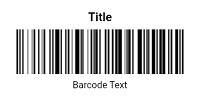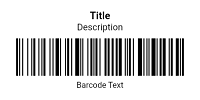The European Article Number (EAN) is a barcode symbology designed to standardize the identification of retail products across international markets. Developed to facilitate global trade, EAN barcodes encode numeric data to streamline product tracking, inventory management, and point-of-sale operations.
The EAN system was introduced in 1976 as an extension of the Universal Product Code (UPC) system. It was developed by the European Article Numbering Association to create a universal standard that could be used globally. The EAN system has since evolved, incorporating several formats to address various needs in product identification and logistics.
Technical Specifications
EAN barcodes are divided into several formats, each catering to different types of products and applications. The most commonly used formats include:
- EAN-13: Encodes 13 digits of numeric data, including a check digit for error detection. It is widely used for product labeling and retail operations.
- EAN-8: A compact version that encodes 8 digits, suitable for smaller packages or items where space is limited. EAN-8 also includes a check digit for accuracy.
- EAN-5: Adds a 5-digit supplemental code to an EAN-13 or EAN-8 barcode, often used for price or other additional information.
- EAN-2: Similar to EAN-5 but encodes only 2 digits, typically used for promotional or additional information.
Each EAN format includes start and stop patterns, encoded data characters, and a check digit to ensure accurate data transmission and scanning.
Check Digit Calculation
The check digit in EAN barcodes is calculated using a modulo 10 algorithm. The process involves:
- Assigning weight factors of 1 and 3 alternately to each digit, starting from the rightmost digit.
- Multiplying each digit by its corresponding weight factor and summing the results.
- Calculating the remainder when this sum is divided by 10.
- Subtracting the remainder from 10 to determine the check digit. If the remainder is 0, the check digit is also 0.
This method helps detect errors in the barcode data, ensuring that the information is accurately represented and processed.
Advantages and Disadvantages
The EAN barcode system offers several advantages, including its international standardization, which ensures compatibility across global markets. Its various formats cater to different needs, from compact labels to detailed product information. The inclusion of a check digit enhances data accuracy and reduces scanning errors.
However, EAN barcodes are limited to numeric data and fixed lengths, which may not accommodate all product information needs. For applications requiring alphanumeric data or more complex encoding, other symbologies such as Code 128 may be more suitable.
EAN Applications
EAN barcodes are widely used across various industries due to their global standardization and efficiency:
- Retail: EAN-13 is commonly used for product labeling and point-of-sale operations, enabling quick and accurate scanning of products at checkout.
- Supply Chain: EAN barcodes facilitate inventory management, tracking products through the supply chain from manufacturing to retail.
- International Trade: Provides a standardized system for product identification that is recognized and accepted worldwide, simplifying cross-border commerce.
Comparison with Other Barcode Symbologies
Compared to UPC, which encodes 12 digits, EAN-13 offers an additional digit, providing a larger number space for product identification. EAN-8 serves as a compact alternative to EAN-13 for smaller packages. While EAN focuses on numeric data, Code 128 supports a broader range of characters, offering more flexibility but requiring more complex scanning equipment.
The EAN barcode system provides a reliable and standardized method for product identification, offering various formats to meet different needs. Its global adoption and efficient design make it an essential tool for retail, supply chain management, and international trade. Despite its limitations to numeric data and fixed lengths, the EAN system's accuracy and compatibility have established it as a fundamental component of modern commerce.


